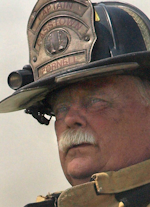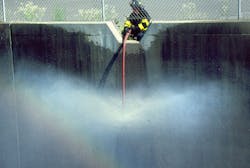Fighting the Fire Below-Using Distributor Nozzles
Last week at Firehouse Expo in Baltimore, I had the honor of participating in a podcast that discussed operations at basement fires. At one point, there was a question from the audience about the use of distributor nozzles, and judging from the response, I thought this might be a good time to review what the device does and go over some tips for its safe operation.
The distributor or cellar nozzle (also called a Bresnan nozzle after one of its inventors) is designed to be used under the surface the operator is standing on. When their use is dictated, it's usually because an inaccessible location or the intensity of a below-grade fire is preventing a direct attack. When needed, nothing else will work as effectively to knock down the fire below.
A rotating distributor nozzle is designed to project water outward and upward, which helps protect the floor from which the crew is operating. Manufacturers offer both straight port and fog port designs, but there is little practical difference in the patterns thrown by the two styles of heads.
All distributor nozzles should be operated at 100-PSI nozzle pressure to provide maximum volume and reach. Keep in mind that overpressurizing the devices may cause them to oscillate from side to side, reducing their effective reach and possibly causing damage if they swing and hit the building structure, stock or fixtures.
The relatively low flow rates of the 1-1/2" versions (usually around 100-GPM) and the size of their water pattern will limit their usefulness at large fires. If you are going to purchase a distributor, go for the 2-1/2" versions that can flow from 250 to 385-GPM. Some manufacturers offer 90-degree applicators, but these will limit the usefulness of the device as you will see below.
The quickest and most efficient method of attacking a fire below is to advance the line down the stairs. But, in some cases, the intensity of the fire creates punishing conditions of high heat and heavy smoke that even the toughest engine companies cannot overcome. In these cases, if the use of a distributor is ordered, a line will be needed at the top of the stairs to prevent the fire's upward travel while the distributor nozzle is operated to reduce the fire's intensity. Operating a distributor nozzle while trying to advance a line down the stairs at the same time is an invitation to serious injury. Ordering a distributor nozzle into operation is the same as ordering exterior streams to operate to the interior of a building...command coordination is a must.
The distributor nozzle should be operated at the end of a 50' length of hose, with a shut off inserted between the first and second lengths. This allows for control of the water flow and certainly makes the crew's job easier. After an access hole is cut, the line is inserted and the water started as soon as the nozzle is below floor level. The line should be fed into the hole until it strikes the floor, and then slowly worked up and down to help the water reach the burning material. Keep in mind that you will be operating blind and one of the only indicators that the water is hitting the fire is when steam starts pushing back from your application hole.
If a fire covers a large area, it might be necessary to apply water from other access holes as well. Make sure you have an additional line on the floor above to cover this operation as any hole you make in the floor becomes an unprotected vertical opening. If the fire is threatening the personnel operating the distributor, it can be left in place, flowing water, as the personnel move to a safer area.
It is especially important to determine the stability of the floor before commencing the use of a distributor nozzle. If lightweight floor framing is present, operating on the floor above an intense fire may not be a good idea as lightweight building components can fail rapidly and without warning.
Because its use is infrequent, it's a good idea for everyone to take time and become familiar and proficient with operating distributor nozzle equipment. A firefighter may have a chance to use a distributor nozzle on an actual fire only once or twice in his or her career, but when that time comes, be assured that no other nozzle will work as well on a fire below.

Capt. Dave Fornell
Captain David P. Fornell is active as a line officer in the Casstown Community Fire Department, Casstown, OH, protecting 88 square miles of rural area in and around Casstown, Ohio. He formerly held the rank of Captain of the Beckerle & Company, Hose Company, Engine #9 of the Danbury, Connecticut fire department protecting a busy city of 85,000, and was the full time Chief of the Westchester, Illinois fire department, a suburb of Chicago. He started his career as a firefighter in the Addison, IL Fire Department, located about 20 miles west of Chicago. Capt. Fornell is a certified fire service instructor specializing in engine company operations, company officer development and fire ground safety courses and he holds the rank of Honorary Battalion Chief of the FDNY. He is the author of "FIRE STREAM MANAGEMENT HANDBOOK" along with an accompanying training video published by Fire Engineering Books and Videos, and served seven years as the Executive Editor of FIRE APPARATUS magazine. Capt. Fornell has written articles for FIRE ENGINEERING and FIREHOUSE magazines in the U.S., FIRE AND RESCUE and MILITARY FIREFIGHTER in the United Kingdom. He has hosted the rural water supply, engine company operations and line officer training segments of "THE FIRST LINE SUPERVISOR" for the FETN television network.






